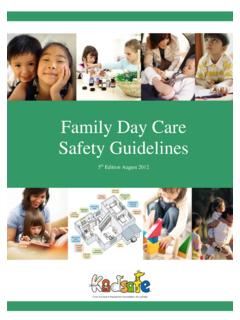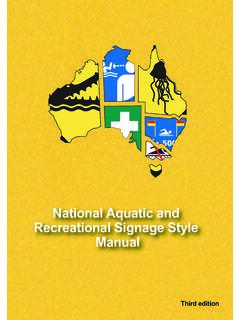Transcription of Family Day Care Safety Guidelines - Kidsafe SA
1 Family Day care Safety Guidelines 6th Edition August 2014 Family Day care Safety Guidelines 1/63 Kidsafe Family Day care Safety Guidelines August 2014 This 6th edition of the Family Day care Guidelines has been reviewed by Kidsafe NSW. Funding was originally provided by the Commonwealth Department of Education, Employment and Workplace Relations.. For further information regarding these Guidelines contact Kidsafe in your state or territory: ACT (02) 6290 2244 NSW (02) 9845 0890 TAS (03) 6249 1063 NT (08) 8985 1085 QLD (07) 3854 1829 VIC (03) 9036 2306 SA (08) 8161 6318 WA (08) 9340 8509 Copyright 2014 You are free to download and copy the Guidelines for use in Family day care schemes.
2 This will not infringe copyright or incur any fee. Such copies must not be offered for sale or published elsewhere. ISBN 0 949 630 24 1 Disclaimer These Guidelines have been prepared from information available to Kidsafe the Child Accident Prevention Foundation of Australia (CAPFA, trading as Kidsafe ) at the time of preparation. This document is aimed at preventing accidental injury to children by identifying potential risks and hazards in the home environment. It is not a manual about dealing with emergencies. Whilst care has been taken to ensure the accuracy of the information provided, Kidsafe takes no responsibility for any errors, omissions or changes to information that may occur, and disclaims all responsibility and liability to any person for any actions taken or not taken because of the information within these Guidelines .
3 This document is a guide only, not a regulation. It does not override state or territory legislation or regulations, national standards or scheme policies (where applicable). Individual state and territory legislation and Guidelines must be consulted in relation to particular standards or requirements, as these vary across Australia. Users of this document may need to amend the Guidelines to include specific local obligations or Guidelines . Where applicable, national standards have been included throughout the document. Family Day care Safety Guidelines 2/63 Kidsafe CONTENTS Acknowledgements .. 3 SECTION ONE Overview .. 4 Introduction .. 4 Guideline aims.
4 5 Using the Guidelines .. 5 Definitions .. 7 SECTION TWO Risk areas and Safety requirements .. 8 A risk management approach .. 8 Australian Standards .. 9 Part 1 Drowning .. 10 Part 2 Falls .. 13 Part 3 Burns and scalds .. 21 Part 4 Lacerations, cuts and crushing .. 25 Part 5 Poisoning .. 29 Part 6 Other injuries .. 31 Part 7 Motor vehicles .. 34 Part 8 Safety management .. 37 SECTION THREE References, resources, standards and contacts .. 39 SECTION FOUR Hazard reduction checklist .. 51 Family Day care Safety Guidelines 3/63 Kidsafe Acknowledgements The Child Accident Prevention Foundation of Australia (CAPFA), trading as Kidsafe is grateful to the executive officers and staff from state and territory Kidsafe offices for their support and expertise in the updating of the Family Day care Safety Guidelines .
5 Kidsafe would also like to acknowledge the expert advice and suggestions provided by the following people as part of the review process for Edition 4. Updates and amendments for following editions have been made with regard to changes in Standards and Regulations: Heather Dunn Policy Officer, Home Based care South Australian Department of Education and Children s Services Belinda Wallis Burns Prevention Researcher, RCH Burns Research Group, Paediatrics and Child Health University of Queensland Pola Nadas Policy Manager Family Day care Australia Siobhan Connolly Burns Prevention/Education Officer, NSW Severe Burns Injury Service NSW Health Department Lauren Cohen Health Promotion Officer, Kids Health Children s Hospital Westmead Ross Maxwell Architect and Director Collard Maxwell Earnshaw Architects Richard Franklin National Manager.
6 Research and Health Promotions Royal Life Saving Society of Australia Kym Groth Resource and Advisory Officer Family Day care Association, Queensland Anita Jovanovski General Manager NSW Family Day care Association Bronwyn Keane Project Worker, Professional Support Services Provider NSW Family Day care Association Liz Chellus Coordinator Marrickville Family Day care (NSW) Casey MacKay Community Development Officer Marrickville Family Day care (NSW) Kerry Yates Coordinator Hurstville Family Day care (NSW) Kara Wilson Community Development Officer Botany Family Day care (NSW) SECTION ONE Overview Family Day care Safety Guidelines 4/63 Kidsafe SECTION ONE Overview Introduction Injury is a major health problem for Australian children.
7 Each year approximately 280 children die as a result of injury (Henley, Kreisfeld & Harrison, 2007). For every one child that dies, a further 160 are hospitalised and 5000 children will need medical attention. Many of these will require ongoing medical care (Berry & Harrison, 2007). Half the children injured are younger than five years old and more than half of these injuries occur at home. Many of these accidental deaths and injuries are avoidable and can either be prevented or injury minimised. By recognising potential risks to children, we can take steps to reduce both the frequency and severity of accidental injury. Putting simple preventative strategies in place can reduce the likelihood of injury.
8 In response to this problem, the Child Accident Prevention Foundation of Australia (CAPFA), known as Kidsafe developed these national Safety Guidelines , which aim to prevent unintentional child injury in home-based education and care services Family day care . Kidsafe is a nationally based charitable, non-government organisation dedicated to the prevention of unintentional childhood injuries and reducing the severity of unintentional injuries to children under the age of 15 years. Its aim of a safer world for children is achieved through community education, research, advocacy, and environmental and legislative change. These Guidelines have been in place since 1986.
9 They are regularly revised with key people from all states and territories, including representatives from state and territory health departments, accident prevention agencies, researchers, privately-owned child care centres and local government-managed Family day care schemes. The Guidelines are designed to draw attention to potential hazards for children and to suggest actions that may be taken to prevent injury. They are not regulations, and they do not override state regulations, national standards or scheme policies (where these apply). SECTION ONE Overview Family Day care Safety Guidelines 5/63 Kidsafe Australian Standards Throughout this document we refer to Australian Standards.
10 These are listed at the beginning of each risk area outlined in section two, and also in the references and resources section (section three). According to Standards Australia ( ) a Standard is a published document which sets out specifications and procedures designed to ensure that a material, product, method or service is fit for its purpose and consistently performs in the way it was intended . Standards establish a common language so that consumers can buy products and services knowing that they have been assessed by experts and are safe and reliable. Furthermore, around a third of all Australian Standards form some part of Territory, State or Federal law. They are at the heart of the Australian Building Code and the Trade Practices Act (Standards Australia - ).





